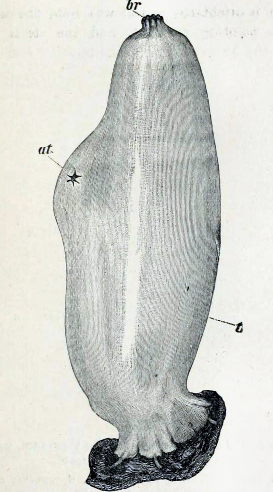Ascidia Mentula on:
[Wikipedia]
[Google]
[Amazon]
''Ascidia mentula'' is a
 ''Ascidia mentula'' has a tough leathery envelope or tunic composed partly of
''Ascidia mentula'' has a tough leathery envelope or tunic composed partly of
species
In biology, a species is the basic unit of classification and a taxonomic rank of an organism, as well as a unit of biodiversity. A species is often defined as the largest group of organisms in which any two individuals of the appropriate s ...
of solitary tunicate
A tunicate is a marine invertebrate animal, a member of the subphylum Tunicata (). It is part of the Chordata, a phylum which includes all animals with dorsal nerve cords and notochords (including vertebrates). The subphylum was at one time ca ...
. It is found in the north east Atlantic Ocean, the Mediterranean Sea and Black Sea. It occurs round the coasts of Britain but is seldom seen on the east coast of England or Scotland.
Description
 ''Ascidia mentula'' has a tough leathery envelope or tunic composed partly of
''Ascidia mentula'' has a tough leathery envelope or tunic composed partly of cellulose
Cellulose is an organic compound with the formula , a polysaccharide consisting of a linear chain of several hundred to many thousands of β(1→4) linked D-glucose units. Cellulose is an important structural component of the primary cell wall ...
. The translucent tunic encloses a fluid-filled body with irregular bulges and two inconspicuous siphons. It is tall, bottle or flask-shaped with the oral (inlet) siphon at the tip and the six-lobed atrial siphon half to two thirds of the way down. The oral siphon has six to eight, often white-tipped, lobes and is surrounded by up to 100 branchial tentacles. It is usually red, pink or sometimes olive green in colour, and may be grey in deep water. It normally adheres to the substrate by the side opposite the atrial siphon.
Distribution and habitat
''Ascidia mentula'' is native to the north eastern Atlantic Ocean, its range extending from Norway southwards to theMediterranean Sea
The Mediterranean Sea is a sea connected to the Atlantic Ocean, surrounded by the Mediterranean Basin and almost completely enclosed by land: on the north by Western and Southern Europe and Anatolia, on the south by North Africa, and on the ea ...
and Black Sea
The Black Sea is a marginal mediterranean sea of the Atlantic Ocean lying between Europe and Asia, east of the Balkans, south of the East European Plain, west of the Caucasus, and north of Anatolia. It is bounded by Bulgaria, Georgia, Roma ...
. It occurs on rocky substrates at depths ranging from subtidal down to . It favours crevices and shady gullies and sometimes adheres to ''Laminaria
''Laminaria'' is a genus of brown seaweed in the order Laminariales (kelp), comprising 31 species native to the north Atlantic and northern Pacific Oceans. This economically important genus is characterized by long, leathery laminae and relativ ...
'' holdfasts, stones and shells.
Biology
''Ascidia mentula'' feeds onplankton
Plankton are the diverse collection of organisms found in Hydrosphere, water (or atmosphere, air) that are unable to propel themselves against a Ocean current, current (or wind). The individual organisms constituting plankton are called plankt ...
that it filters from seawater with a mucous
Mucus ( ) is a slippery aqueous secretion produced by, and covering, mucous membranes. It is typically produced from cells found in mucous glands, although it may also originate from mixed glands, which contain both serous and mucous cells. It is ...
net. A small bivalve mollusc ('' Modiolarca tumida'') often lives within the tunic in the body cavity which may also be occupied by a small pea crab
The pea crab, ''Pinnotheres pisum'', is a small crab in the family Pinnotheridae that lives as a parasite in oysters, clams, mussels, and other species of bivalves.
Description
Pea crabs are small crustaceans about the size of a pea or dime, wit ...
('' Pinnotheres pinnotheres'') and a copepod
Copepods (; meaning "oar-feet") are a group of small crustaceans found in nearly every freshwater and saltwater habitat (ecology), habitat. Some species are planktonic (inhabiting sea waters), some are benthos, benthic (living on the ocean floor) ...
('' Notopterophorus papilio'').
Breeding takes place mainly in the summer. Fertilization is external and the tadpole larvae spend a short time in the plankton before settling on the seabed, undergoing metamorphosis
Metamorphosis is a biological process by which an animal physically develops including birth or hatching, involving a conspicuous and relatively abrupt change in the animal's body structure through cell growth and differentiation. Some inse ...
and becoming juveniles.
References
{{Taxonbar, from=Q3624860 Phlebobranchia Animals described in 1776 Taxa named by Otto Friedrich Müller